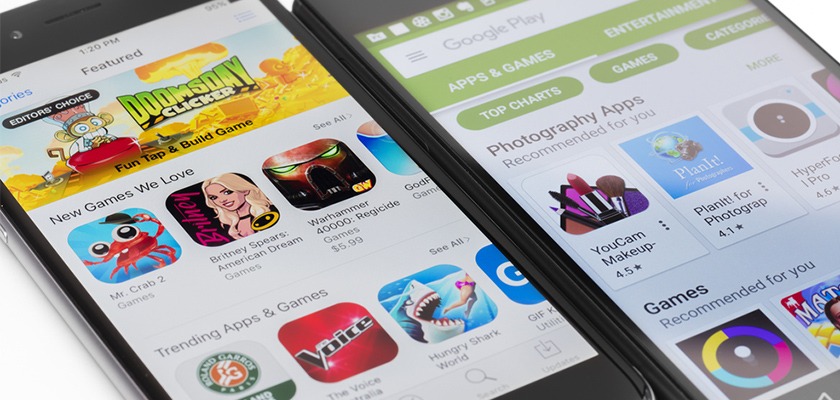
10 Things to know About App Store Ad Campaign Setup
10 Things to know About App Store Ad Campaign Setup
According to Business Insider, the ad revenue generated for app installations is projected to be $6.1 billion by the end of 2017 and will grow to $6.8 by 2019.The competition is increasing and you should plan your app store campaign carefully.
This year alone, Statista shows there were over 224 million mobile apps downloaded worldwide. With such a large audience, your business may want to start considering a paid install campaign as part of your 2017 digital marketing strategy. These 10 things will help your business along its journey to setting up an app store ad campaign.
Consumers in the United States spend around 90% of their time using apps while on their mobile devices. Social media apps like Instagram and Snapchat are capturing the attention of millennials, moms across the nation are hooked on Pinterest, and Candy Crush still saves millions from boredom every day. 140 billion apps have been downloaded from the app store since its inception and the number just keeps growing.
With this many consumers interacting with apps on a daily and consistent basis, advertisers have jumped on the bandwagon to utilize these platforms for businesses. Google AdMob is one of the largest mobile advertisers with over 1,000,000+ Google advertisers and 1 million apps using its services. To help your business begin its advertising journey with apps, here are 10 things you need to know about app store ad campaign set up.
Read the case study: How Colgate-Palmolive accelerated Ad Campaign Optimization
With Adverity, the company is now able to optimize ad campaigns much faster and with more confidence, significantly improving campaign efficiency and budget allocation.
1. A Campaign Made for Mobile
One of the first questions to ask yourself on this journey is where you want users to see your advertisements? When creating your app store ad campaign, like any other, you must first determine its nature. Search has always been a huge factor when it comes to optimization.
However, according to leading digital agency Aumcore, mobile app display networks are the way to go. They generate more traffic and, in turn, increase your brand’s visibility. Consider the benefits of both search and display and what will work best for your business in a mobile app store ad campaign. To start things off, select “Mobile app installs” from the available campaign types in order to see your app displayed in the Apple app store and Google Play.
2. Optimize for All Devices
Considering that users spend 90% of their mobile time in an app, it’s easy to see that mobile devices are just as important, if not more, as desktop devices for this particular campaign.
However, don’t forget your desktop users. You want to be sure your campaign is optimized for all platforms. Don’t limit your campaign either, and consider the implications of iOS vs. Android. To do this and to broaden the reach of your campaign, select “All available operating systems.”
3. Choose the Network that’s Best for Your Business
Certain platforms will drive low quality users to your ad. This means that a vast amount of traffic will be directed towards your campaign with no actions taken. For your business to achieve positive results, determine which networks are driving high quality users. So, you need a marketing strategy for your app.
Depending on your business’ unique goals, success could mean anything from downloads to engagement. Once you have determined your factor for success, find out which network will service your business the best.
4. Stay within Your Means
Success doesn’t mean breaking the bank. Although we all want those viral numbers, bankrupting your business in the process is not part of the plan. Set a realistic budget for your business when it comes to your app store ad campaign.
If you’re a small to medium sized business and you’re a bit uncomfortable handling finances for the campaign, enlisting an agency may be the path for you. If not, make sure you’re focused on a specific result for your bid strategy and stay within your means!
5. Think About Organic Growth
Consumers will usually search for an app directly or find one along the way. You need to get help from ASO tips & tricks. Raising the number of app installs plays a huge factor in increasing your business’ visibility because it determines the placement of your app within the store, a process known as app store optimization.
Paid sources will help boost downloads as well as your organic growth because more people will be exposed to your app if they see it’s gaining popularity and momentum. Use this approach as part of your app store ad campaign set up and see if your business needs more face time with your audience.
6. Click Insurance
Tracking clicks can be time consuming, and difficult to trace back to the original source. To better understand the user journey, make sure the connections you have set up are tracking the user’s last click. This is especially important if you are on a tight budget because it could mean over-charging on your end.
7. Seal the Deal with Your Users
What’s your call to action? Are users compelled to download your app when they see your ad? It’s always best to do a bit of research and see what will attract consumers to you. A large part of any campaign is making sure you’re in the right place and the right time, but captivating your target audience will seal the deal. Determine whether your campaign will focus on clicks or installs and make the selection as shown below.
8. User Experience (UX) is Still Important
Along with a plethora of models available in the market, there are also different versions of operating systems to consider. By targeting specific devices, you can determine which system will support your app the best. A well thought out UX helps drive traffic, so plan ahead. Think about factors like iOS vs. Android or Wi-Fi-only connections to better service your target audience.
9. Analyze the Data
According to Hubspot, cohort analyses provide a comprehensive understanding of your KPI’s. They’re used to compare the engagement (number of sessions, frequency of visits, etc.) or monetization (in-app purchases, ARPU, ARPPU, LTV, etc.) of various user segments.
This information is invaluable in helping app marketers optimize their future ad spend and targeting. Being able to compare different cohorts enables your business to get specifics about where you’re gaining the most traction from your campaign.
10. Measure Success
Whether it’s raising installs, driving traffic, or increasing engagement, don’t lose sight of the goals your business initially set in place when creating its app store ad campaign. One of the biggest contributors to seeing positive results is keeping everything on track. Remember to remind your team about the end goal and what success means and looks like for your business!










